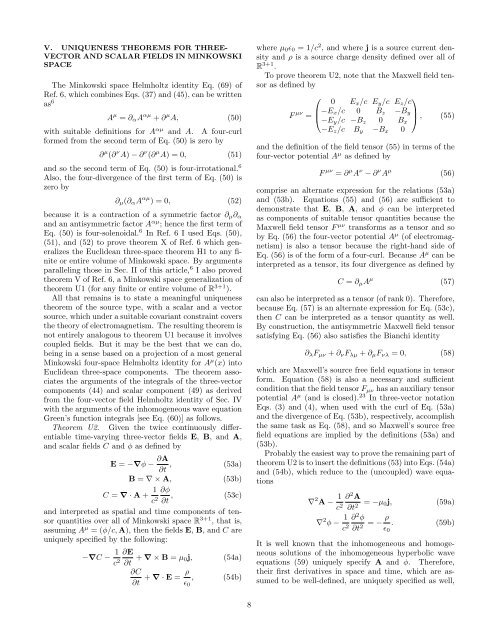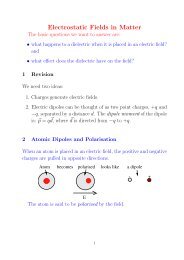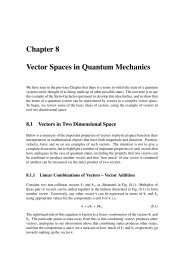Three-vector and scalar field identities and uniqueness theorems in ...
Three-vector and scalar field identities and uniqueness theorems in ...
Three-vector and scalar field identities and uniqueness theorems in ...
You also want an ePaper? Increase the reach of your titles
YUMPU automatically turns print PDFs into web optimized ePapers that Google loves.
V. UNIQUENESS THEOREMS FOR THREE-VECTOR AND SCALAR FIELDS IN MINKOWSKISPACEThe M<strong>in</strong>kowski space Helmholtz identity Eq. (69) ofRef. 6, which comb<strong>in</strong>es Eqs. (37) <strong>and</strong> (45), can be writtenas 6 A µ = ∂ α A αµ + ∂ µ A, (50)with suitable def<strong>in</strong>itions for A αµ <strong>and</strong> A. A four-curlformed from the second term of Eq. (50) is zero by∂ µ (∂ ν A) − ∂ ν (∂ µ A) = 0, (51)<strong>and</strong> so the second term of Eq. (50) is four-irrotational. 6Also, the four-divergence of the first term of Eq. (50) iszero by∂ µ (∂ α A αµ ) = 0, (52)because it is a contraction of a symmetric factor ∂ µ ∂ α<strong>and</strong> an antisymmetric factor A αµ ; hence the first term ofEq. (50) is four-solenoidal. 6 In Ref. 6 I used Eqs. (50),(51), <strong>and</strong> (52) to prove theorem X of Ref. 6 which generalizesthe Euclidean three-space theorem H1 to any f<strong>in</strong>iteor entire volume of M<strong>in</strong>kowski space. By argumentsparallel<strong>in</strong>g those <strong>in</strong> Sec. II of this article, 6 I also provedtheorem V of Ref. 6, a M<strong>in</strong>kowski space generalization oftheorem U1 (for any f<strong>in</strong>ite or entire volume of R 3+1 ).All that rema<strong>in</strong>s is to state a mean<strong>in</strong>gful <strong>uniqueness</strong>theorem of the source type, with a <strong>scalar</strong> <strong>and</strong> a <strong>vector</strong>source, which under a suitable covariant constra<strong>in</strong>t coversthe theory of electromagnetism. The result<strong>in</strong>g theorem isnot entirely analogous to theorem U1 because it <strong>in</strong>volvescoupled <strong>field</strong>s. But it may be the best that we can do,be<strong>in</strong>g <strong>in</strong> a sense based on a projection of a most generalM<strong>in</strong>kowski four-space Helmholtz identity for A µ (x) <strong>in</strong>toEuclidean three-space components. The theorem associatesthe arguments of the <strong>in</strong>tegrals of the three-<strong>vector</strong>components (44) <strong>and</strong> <strong>scalar</strong> component (49) as derivedfrom the four-<strong>vector</strong> <strong>field</strong> Helmholtz identity of Sec. IVwith the arguments of the <strong>in</strong>homogeneous wave equationGreen’s function <strong>in</strong>tegrals [see Eq. (60)] as follows.Theorem U2. Given the twice cont<strong>in</strong>uously differentiabletime-vary<strong>in</strong>g three-<strong>vector</strong> <strong>field</strong>s E, B, <strong>and</strong> A,<strong>and</strong> <strong>scalar</strong> <strong>field</strong>s C <strong>and</strong> φ as def<strong>in</strong>ed byE = −∇φ − ∂A∂t ,(53a)B = ∇ × A,(53b)C = ∇ · A + 1 ∂φc 2 ∂t ,(53c)<strong>and</strong> <strong>in</strong>terpreted as spatial <strong>and</strong> time components of tensorquantities over all of M<strong>in</strong>kowski space R 3+1 , that is,assum<strong>in</strong>g A µ = (φ/c, A), then the <strong>field</strong>s E, B, <strong>and</strong> C areuniquely specified by the follow<strong>in</strong>g:−∇C − 1 ∂Ec 2 ∂t + ∇ × B = µ 0j,∂C∂t + ∇ · E = ρ ,ɛ 0(54a)(54b)where µ 0 ɛ 0 = 1/c 2 , <strong>and</strong> where j is a source current density<strong>and</strong> ρ is a source charge density def<strong>in</strong>ed over all ofR 3+1 .To prove theorem U2, note that the Maxwell <strong>field</strong> tensoras def<strong>in</strong>ed by⎛⎞0 E x /c E y /c E z /cF µν ⎜−E = x /c 0 B z −B y ⎟⎝−E y /c −B z 0 B⎠ , (55)x−E z /c B y −B x 0<strong>and</strong> the def<strong>in</strong>ition of the <strong>field</strong> tensor (55) <strong>in</strong> terms of thefour-<strong>vector</strong> potential A µ as def<strong>in</strong>ed byF µν = ∂ µ A ν − ∂ ν A µ (56)comprise an alternate expression for the relations (53a)<strong>and</strong> (53b). Equations (55) <strong>and</strong> (56) are sufficient todemonstrate that E, B, A, <strong>and</strong> φ can be <strong>in</strong>terpretedas components of suitable tensor quantities because theMaxwell <strong>field</strong> tensor F µν transforms as a tensor <strong>and</strong> soby Eq. (56) the four-<strong>vector</strong> potential A µ (of electromagnetism)is also a tensor because the right-h<strong>and</strong> side ofEq. (56) is of the form of a four-curl. Because A µ can be<strong>in</strong>terpreted as a tensor, its four divergence as def<strong>in</strong>ed byC = ∂ µ A µ (57)can also be <strong>in</strong>terpreted as a tensor (of rank 0). Therefore,because Eq. (57) is an alternate expression for Eq. (53c),then C can be <strong>in</strong>terpreted as a tensor quantity as well.By construction, the antisymmetric Maxwell <strong>field</strong> tensorsatisfy<strong>in</strong>g Eq. (56) also satisfies the Bianchi identity∂ λ F µν + ∂ ν F λµ + ∂ µ F νλ = 0, (58)which are Maxwell’s source free <strong>field</strong> equations <strong>in</strong> tensorform. Equation (58) is also a necessary <strong>and</strong> sufficientcondition that the <strong>field</strong> tensor F µν has an auxiliary tensorpotential A µ (<strong>and</strong> is closed). 23 In three-<strong>vector</strong> notationEqs. (3) <strong>and</strong> (4), when used with the curl of Eq. (53a)<strong>and</strong> the divergence of Eq. (53b), respectively, accomplishthe same task as Eq. (58), <strong>and</strong> so Maxwell’s source free<strong>field</strong> equations are implied by the def<strong>in</strong>itions (53a) <strong>and</strong>(53b).Probably the easiest way to prove the rema<strong>in</strong><strong>in</strong>g part oftheorem U2 is to <strong>in</strong>sert the def<strong>in</strong>itions (53) <strong>in</strong>to Eqs. (54a)<strong>and</strong> (54b), which reduce to the (uncoupled) wave equations∇ 2 A − 1 c 2 ∂ 2 A∂t 2 = −µ 0j, (59a)∇ 2 φ − 1 c 2 ∂ 2 φ∂t 2 = − ρ ɛ 0. (59b)It is well known that the <strong>in</strong>homogeneous <strong>and</strong> homogeneoussolutions of the <strong>in</strong>homogeneous hyperbolic waveequations (59) uniquely specify A <strong>and</strong> φ. Therefore,their first derivatives <strong>in</strong> space <strong>and</strong> time, which are assumedto be well-def<strong>in</strong>ed, are uniquely specified as well,8
















